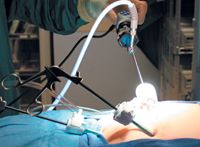Minimal access surgery in infants and children
Minimal access surgery is the fastest-growing area of surgical innovation, and children certainly benefit from procedures previously associated with more invasive approaches.

Key Points
The field of minimal access surgery (MAS) is rapidly evolving. It is associated with less painful incisions, shorter hospitalizations, faster return to normal activity, and a shorter recovery period. Naturally, infants, children, and adolescents represent an ideal population who will benefit from MAS techniques. Parents favor eliminating the surgical insult and want improved cosmetic outcomes.
The pediatric surgical community has embraced MAS, and most common procedures in children are carried out via a telescopic approach through incisions as small as 3 mm. In fact, surgery for appendicitis, cholecystitis, pyloric stenosis, gastroesophageal reflux disease, and inguinal hernias are common procedures performed by pediatric surgeons using MAS.
Surgery is controlled trauma. Every incision results in a host of metabolic and endocrine responses that range from local to systemic, with myriad consequences for the patient. These responses are significantly modulated by the size of the surgical incisions, because the larger the incision of fascia, muscle, and/or viscera, the greater the humoral and catabolic response of the body.1,2
Minimal access surgery was introduced in the 1980s as a way to perform surgery without having to make large incisions to gain access to the body cavity. In adults, MAS is associated with improved cosmesis, less pain, quicker recoveries, and a faster return to work and other activities of daily living.3 The use of MAS was reported as a success in children, and subsequently these techniques have been expanded to more common pediatric surgical conditions, even in infants as small as 550 g.4
There was an initial reluctance by many pediatric surgeons to adopt MAS for their patient population.5 They felt that the benefits of MAS in children were less evident because surgical incisions were usually small and children recovered from even major operations rapidly, with relatively fewer analgesic requirements than adults, and returned to school and other activities quickly. Others, however, recognized an opportunity to further minimize the surgical insult and to optimize overall outcomes.
Early reports demonstrated the applicability and efficacy of MAS in pediatric surgical patients, but its use was limited to older children because the only available instruments were sized for adults.6 Subsequent modifications, improved optics, and new designs have allowed MAS to be performed in nearly all pediatric patients, including newborns.7
Techniques and instrumentation
Minimal access surgery uses a range of techniques. These include multiport-site, single-site, and natural-orifice transluminal endoscopic surgery (NOTES). Each approach requires intra-abdominal insufflation of carbon dioxide (CO2) to maintain adequate space for operative visualization.



Artificial intelligence improves congenital heart defect detection on prenatal ultrasounds
January 31st 2025AI-assisted software improves clinicians' detection of congenital heart defects in prenatal ultrasounds, enhancing accuracy, confidence, and speed, according to a study presented at SMFM's Annual Pregnancy Meeting.